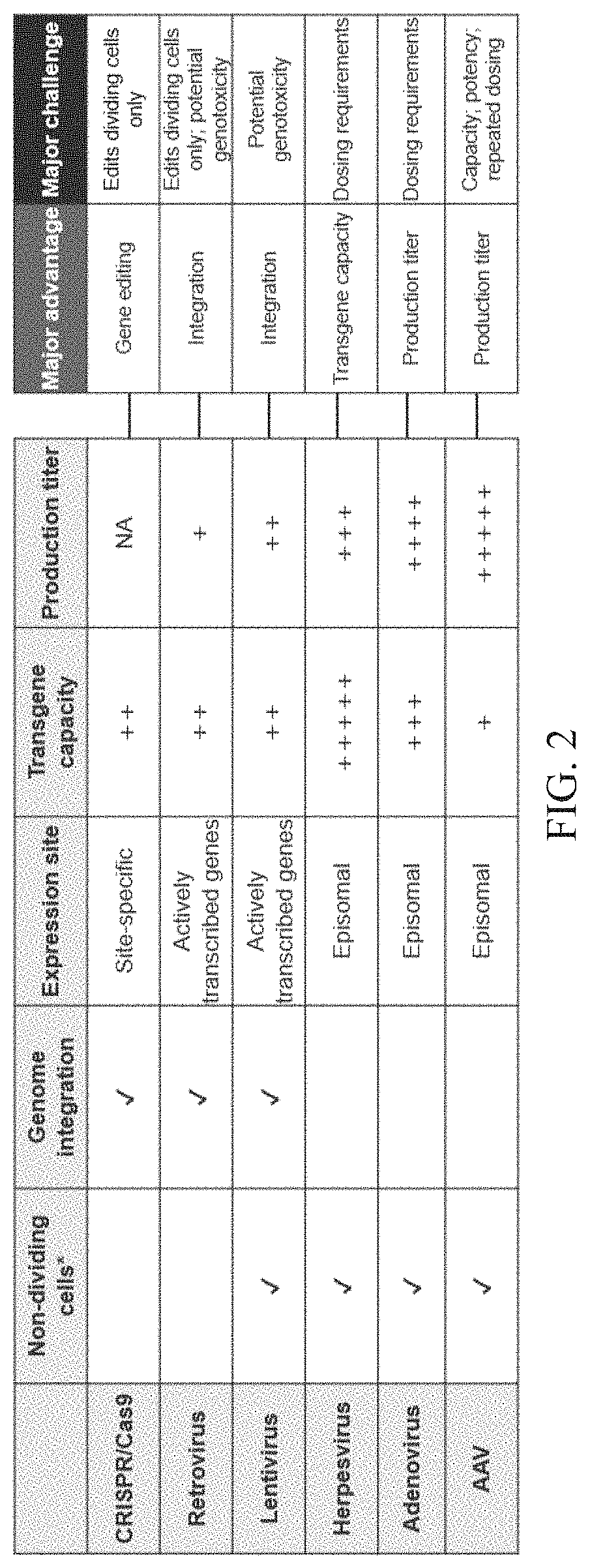Nucleic acid therapeutics for genetic disorders
a technology of nucleic acid and genetic disorders, applied in the field of nucleic acid therapeutics for genetic disorders, can solve the problems of limited efficacy, limited capacity and usefulness of high doses, and significant limitations, and achieve the effects of increasing the stability of nucleic acid molecules, increasing the stability of encoded proteins, and increasing the stability of rna molecules
- Summary
- Abstract
- Description
- Claims
- Application Information
AI Technical Summary
Benefits of technology
Problems solved by technology
Method used
Image
Examples
example 1
ded Minimal Lentiviral Machinery for In Vivo Gene Therapy
[0143]A transgene-encoding template was designed as shown in FIG. 3. The transgene-encoding nucleic acid template comprises, from 5′ to 3′, a 5′ LTR, a reverse transcriptase priming element, a promoter operably linked to a transgene, an enhancer, and a 3′ LTR. Additional RNA production elements include a 5′ T7 RNA polymerase promoter and a 3′ digest site. The RNA molecule produced from the transgene-encoding nucleic acid template comprises unmodified nucleosides since retroviral reverse transcriptases cannot copy modified ribonucleases (Swanstrom et al., J. Biol. Chem. 256:1115-1121(1981)). Additionally, the RNA has a 5′-7mG cap structure and a poly(rA) tail to enhance RNA stability.
[0144]Two minimal nucleic acid templates encoding Pol poly proteins (for reverse transcription / integration) were designed as shown in FIG. 4. The canonical gene construction provides for the gag and pol to be expressed inline, which requires transl...
example 2
elivery of Beta-Globin to Treat Sickle Cell Disease
[0146]A transgene-encoding nucleic acid templates as described in Example 1 comprising a beta-globin transgene is used to produce an RNA molecule comprising the beta-globin gene flanked by LTRs for integration into a host cell genome. A nucleic acid template comprising, from 5′ to 3′, a 5′ UTR, a nucleic acid sequence encoding retroviral Pol polyprotein components in the form of a Pol polyprotein, and a 3′ UTR, as described in Example 1 is used to produce an RNA molecule encoding retroviral Pol proteins.
[0147]An effective amount of a lipid nanoparticle composition comprising the two RNA molecules is administered to a patient suffering from sickle cell disease to treat sickle cell disease.
example 3
RNA Stability and Translation in Human Cells
[0148]The lentivirus-derived genes forming the basis of the RNA-mediated transgene integration systems described herein can pose challenges for synthetic gene expression in cells. Lentiviral replication steps undergo tightly-controlled spatiotemporal processes that are orchestrated by a full complement of viral genes and regulatory elements, structural proteins, replicative enzymes, and interaction with host factors critical for replication. This example describes several modifications to increase stability and efficiency of the RNA-based integration system.
Increased Stability of Functional Unit RNAs
[0149]The one or more nucleic acid molecules encoding one or more Pol polyprotein components and / or accessory proteins are also referred to as “functional unit nucleic acids.” The generation of a minimal, integration-competent RNA system generally entails the removal of viral genes that do not directly influence reverse transcription and provir...
PUM
| Property | Measurement | Unit |
|---|---|---|
| diameter | aaaaa | aaaaa |
| diameter | aaaaa | aaaaa |
| nucleic acid | aaaaa | aaaaa |
Abstract
Description
Claims
Application Information
 Login to View More
Login to View More - R&D
- Intellectual Property
- Life Sciences
- Materials
- Tech Scout
- Unparalleled Data Quality
- Higher Quality Content
- 60% Fewer Hallucinations
Browse by: Latest US Patents, China's latest patents, Technical Efficacy Thesaurus, Application Domain, Technology Topic, Popular Technical Reports.
© 2025 PatSnap. All rights reserved.Legal|Privacy policy|Modern Slavery Act Transparency Statement|Sitemap|About US| Contact US: help@patsnap.com



